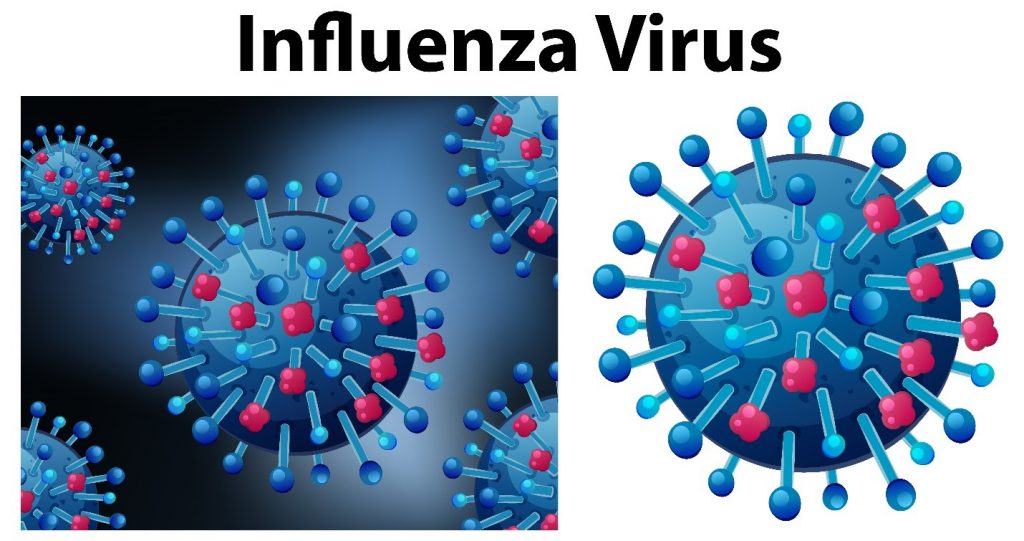What are the subtle differences between COVID-19 and influenza virus infection?
The clinical manifestation of flu virus and coronavirus in individuals differ based on various factors such as the host immunity, virus strains, presence of chronic medical conditions and the age. For instance, flu virus and coronavirus causes severe disease in elderly people with pre-existing respiratory conditions like chronic obstructive pulmonary diseases unlike in healthy young patients.
The major differences between seasonal flu and COVID-19 are outlined below.

Causative Organisms
Coronavirus is caused by virus strain called SARS-CoV-2 which is a novel virus while seasonal flu is caused by 2 major virus strains: influenza A and B viruses. The COVID-19 and seasonal flu viruses differ in their structure, chemical component and disease mechanism.

Incubation Period
This is the period between exposure to the virus and manifestation of symptoms. For seasonal flu, flu symptoms manifest after 1-4 days of being exposed to the virus while for coronavirus infection, it varies and may take 2-14 days.
Generally, flu symptoms appear faster than coronavirus symptoms which are gradual in onset. However, before symptoms appear, COVID-19 causes more person to person transmission than seasonal influenza.

What's the difference between COVID-19 and the flu?
Professor Robert Booy from the University of Sydney, Head of Clinical Research at the National Centre for Immunisation Research and Surveillance, answers the following questions about this topic.

Severity Of Clinical Symptoms
Approximately 20% of coronavirus cases have been shown to be severe and require hospitalisation unlike 1% of seasonal flu cases that require hospitalization.
Respiratory symptoms such as fever, cough, fatigue and difficulty in breathing are more severe in coronavirus infection than seasonal flu virus infection. According to a research study, reported cases of fever, vomiting, diarrhea and headache were more common in children diagnosed with coronavirus than those with seasonal flu. According to a research study, loss of smell was seen in 64.5% of patients diagnosed with coronavirus infection. Thus, coronavirus infected individuals usually have lost their sense of taste and smell.
Complications
Patients with coronavirus are more prone to complications than those with seasonal flu.
Also, blood clot formation in the heart and lungs is more associated with coronavirus infection and unlikely with flu infection. A recent study showed that 31% of COVID-19 patients admitted in a hospital’s intensive care unit formed blood clots in the lungs and cardiovascular system.
Early detection and prompt intervention reduce the possibilities of developing complications in either flu or coronavirus infection.
Mortality Rate
Due to the severity of coronavirus infection and its faster mode of spread, the number of covid-19 associated deaths globally is more compared to seasonal flu.
According to the Australian Ministry of Health, as at 19th October 2020, there were 905 COVID-19 related deaths and 36 flu-related deaths in Australia.
As at 19th October 2020, the World health organization estimates 1.11 million deaths globally due to COVID-19 infection while global flu-related deaths are estimated to be between 290,000- 650,000.
Diagnostic Tests
Diagnosis of coronavirus and seasonal flu requires carrying out either rapid diagnostic tests or molecular tests which are more accurate to detect the viral proteins specific for either the flu virus or COVID- 19 virus.
In addition to nasal swab samples, saliva samples can be used to test for COVID-19 and not for seasonal flu.
For seasonal flu diagnosis, the rapid diagnostic tests identify proteins specific to the flu virus while coronavirus rapid diagnostic kits test for antibodies in blood samples to COVID-19 virus. The genetic material for the flu virus and COVID-19 virus differ in structure and this forms the basis for specific molecular tests carried out to uniquely identify the genetic material for the viruses.
Available Treatment Options
Influenza treatment is achieved by using licensed oral antiviral medications which can be taken at home. These antiviral medications are in various forms like tablets and liquids.
On the other hand, clinical trials for developing drugs for treating coronavirus infected patients are still in progress. Remdesivir is one of the drugs in clinical trials that have been shown to be effective in treating COVID-19 infected patients. According to a recent randomized control study, researchers discovered that Remdesivir improved the recovery rate of hospitalized COVID -19 patients and decreased progression in those with severe COVID-19 infection.
Prevention
Seasonal flu is prevented by taking seasonal flu vaccine shots before the flu season to prevent the duration and severity of flu. These vaccines are uniquely updated annually to cover the different flu virus strains. Flu season in Australia peak in August every year, therefore, flu vaccine shot should be taken in early April to boost the immune system before the intense period.
Flu vaccine shot is recommended for children above 6 months and for all adults.
The Flu vaccine is an inactivated viral antigen which means you are protected from contracting the flu virus from the vaccine. Tolerable vaccine side effects such as mild fever and muscle aches are expected although they are self-limiting.
In contrast, there are no licensed COVID-19 vaccines to prevent coronavirus infection at the moment. Of note, current coronavirus vaccine in the clinical trial phase are in various forms such as inactivated vaccines, mRNA vaccine, DNA vaccine and other types that contain viral antigens and protein molecules.
Conclusion
Coronavirus and flu virus both cause respiratory infections which vary in severity, clinical course and progression depending on host factors highlighted and prompt intervention. These 2 viruses vary in terms of their physical and chemical components and structure, incubation period, available treatment and prevention options.
Although coronavirus vaccine is not available, the seasonal flu shot is, and it is recommended during this season to prevent flu infection.
Workplace flu vaccination is a recommended way of getting your seasonal flu shots to protect your health during this flu season. Corporate Care runs annual influenza programs in Australia and New Zealand.
We are Flu Experts
FLU VACCINATIONS MADE EASY
- Behind the Syringe
- Flu Insights

Introducing Aitor Aspiazu, your go-to flu expert and a Registered Nurse accredited by AHPRA (NMW0001159845). Boasting over two decades of experience in healthcare, Aitor has navigated everything from Emergency Departments to Corporate Wellness Programs—and yes, he’s even battled the flu himself. As the Founder and Lead Nurse Consultant at Corporate Care, he’s the driving force behind workplace health and well-being. No longer in scrubs, he’s now at the forefront of healthcare innovation, leveraging Artificial Intelligence and automation to revolutionise workplace health and well-being. As the Founder and Lead Nurse Consultant at Corporate Care, he’s the visionary behind cutting-edge flu vaccination programs that keep businesses running smoothly. Off-duty, he’s a proud dad and a Padel addict who represented Australia in the World Padel Championship. Trust Aitor; he’s got your back when it comes to flu prevention and modern healthcare solutions.
